It’s 2025, and most marketers are still chasing rankings and traffic as their north star. But these metrics don’t always translate into business results.
I’ve helped luxury brands suffering from declining clicks increase revenue by nearly 100% using a combination of brand, audience, and SEO strategy.
In this article, I’ll show you how to grow organic revenue with a similar approach so you can squeeze more juice from your search traffic.
Search may be evolving, but people still want the same thing
Search today looks different from a year ago. Google is no longer the only discovery channel. People are finding answers on ChatGPT, TikTok, Reddit, and Gemini.
SEO teams are under pressure to show up everywhere and drive more traffic. However, more traffic is not the answer.
It’s important to remember that people still want the same things:
- To know (Informational)
- To go (Navigational)
- To do (Commercial)
- To buy (Transactional)
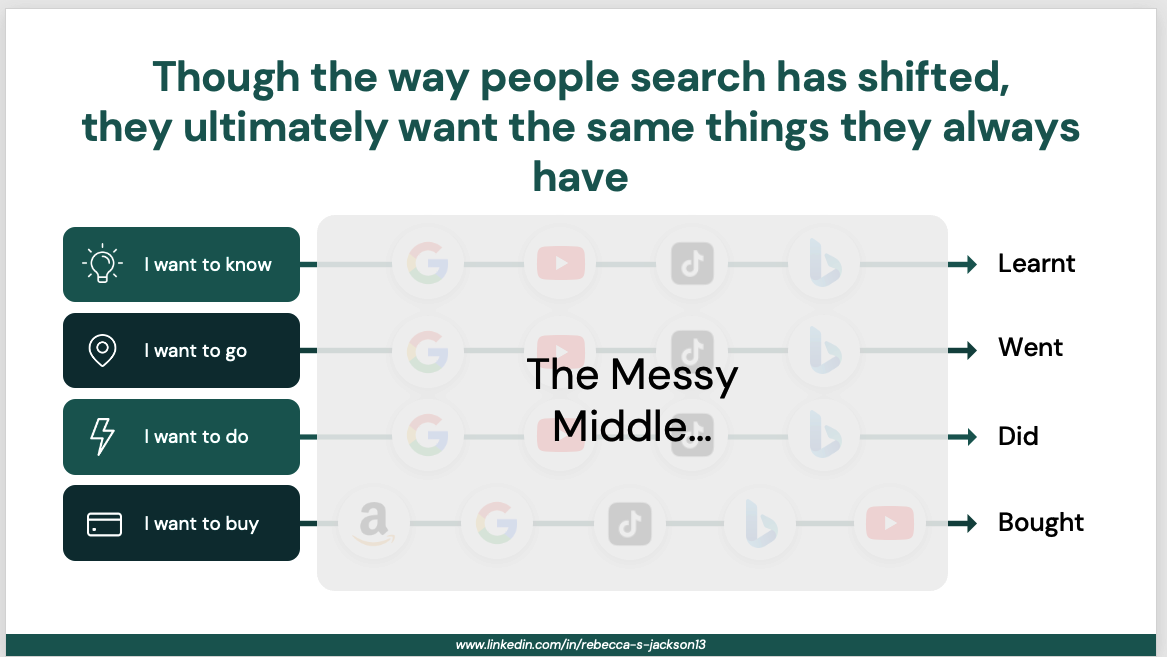
One of our luxury clients at Croud saw impressions rising steadily, but clicks remained flat. From a traditional performance view, nothing had improved. But when we stopped obsessing over traffic and focused on intent, revenue grew by 98% in six months.
Our job as SEOs is evolving from driving traffic to providing a product experience that generates sales even with fewer clicks.
Don't miss the SEO event of the year
Get actionable strategies to improve your SEO skills, only at MozCon New York

Know your audience before you pick keywords
Before doing keyword research, I start with audience profiling. You need to know who you're targeting before deciding how to reach them. Skipping this step results in content that ranks but doesn’t convert.
Use GA4 to get a baseline view of your audience
Open the User Attributes report in GA4 and export 12 months of organic data.
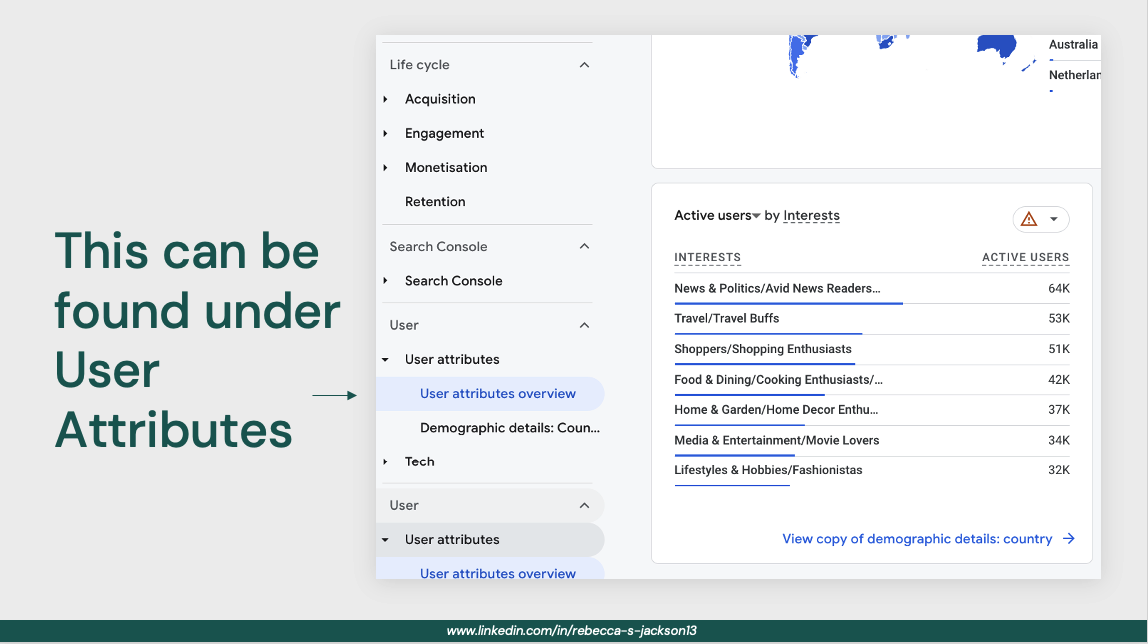
The report shows you who’s landing on your site from search. Focus on age, gender, and interest categories.
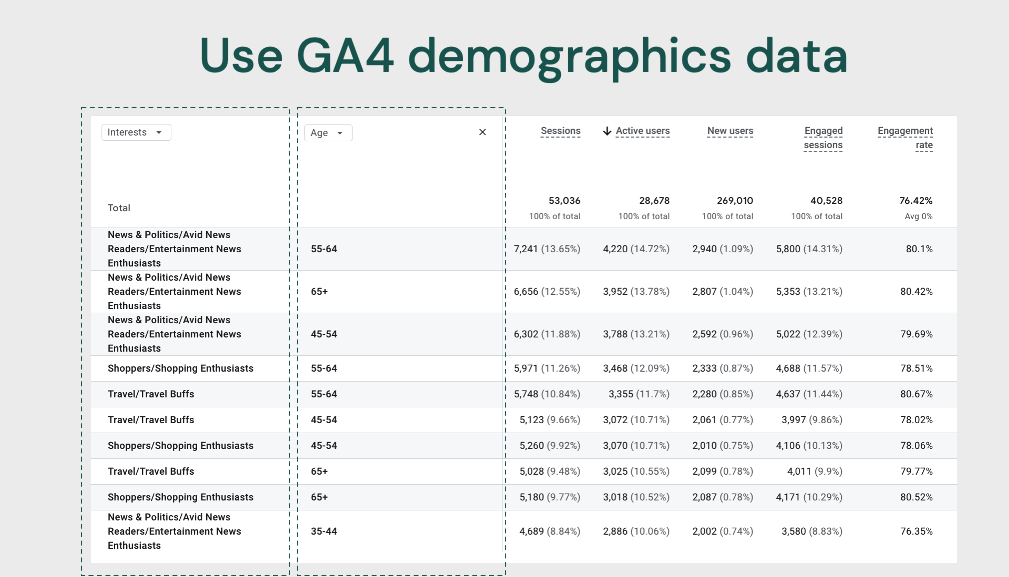
Use the data to understand if you're attracting your preferred audience and identify gaps in who’s engaging versus buying.
Use SparkToro to map where and how your audience spends time
Take the GA4 segments and drop them into SparkToro.
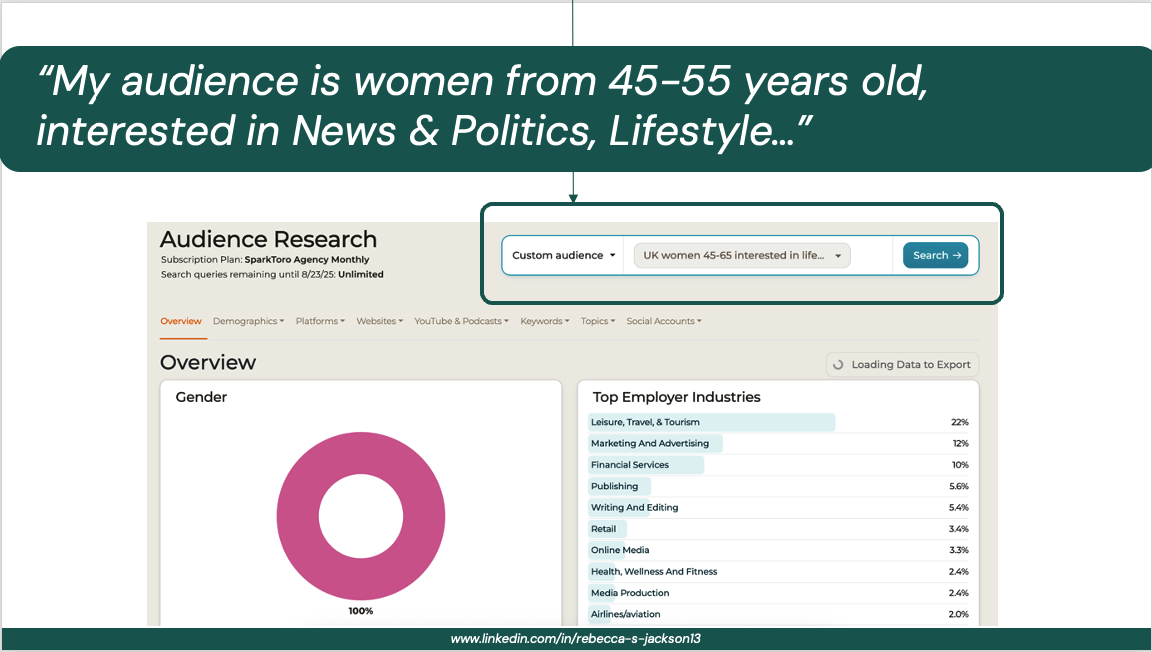
Analyze the platforms they use, which creators they follow, and the topics they care about. The data reveals where your audience is active and what influences them.
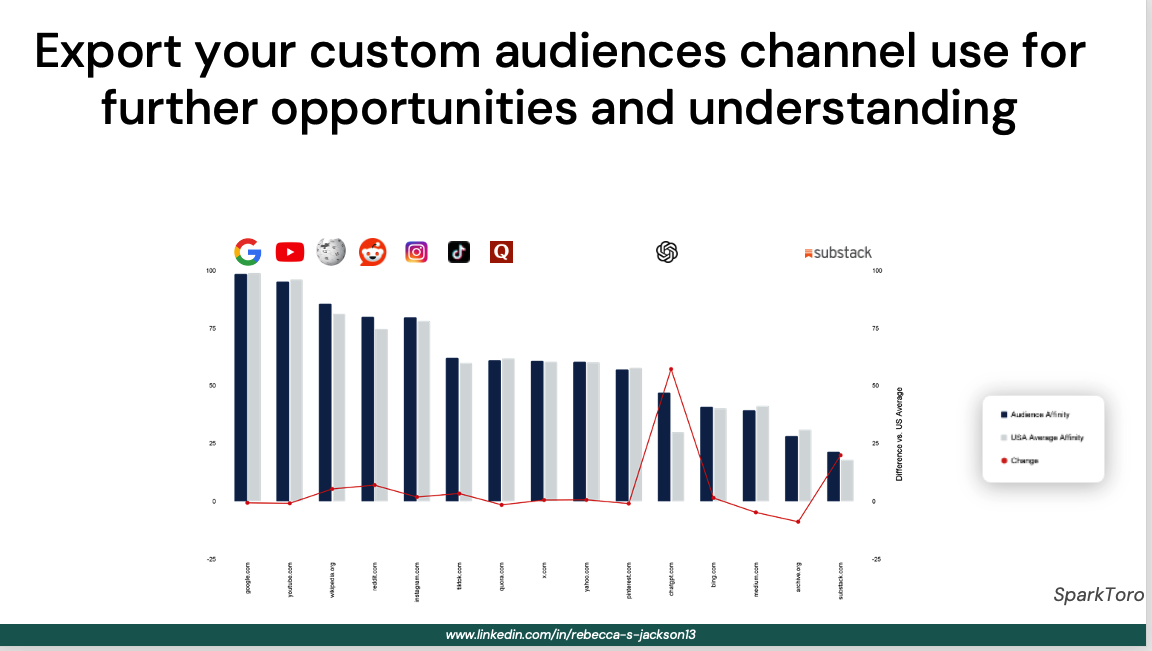
This is where intent becomes visible. A user searching on Reddit is in a different mindset than one browsing Pinterest. Knowing that changes how you write, where you publish, and how you frame your message.
Use GWI to build out behavior-rich personas
To get deeper, I use GWI to run market-specific surveys and dig into why people buy. For luxury clients, I focus on questions like: What do you value most when researching a luxury brand?
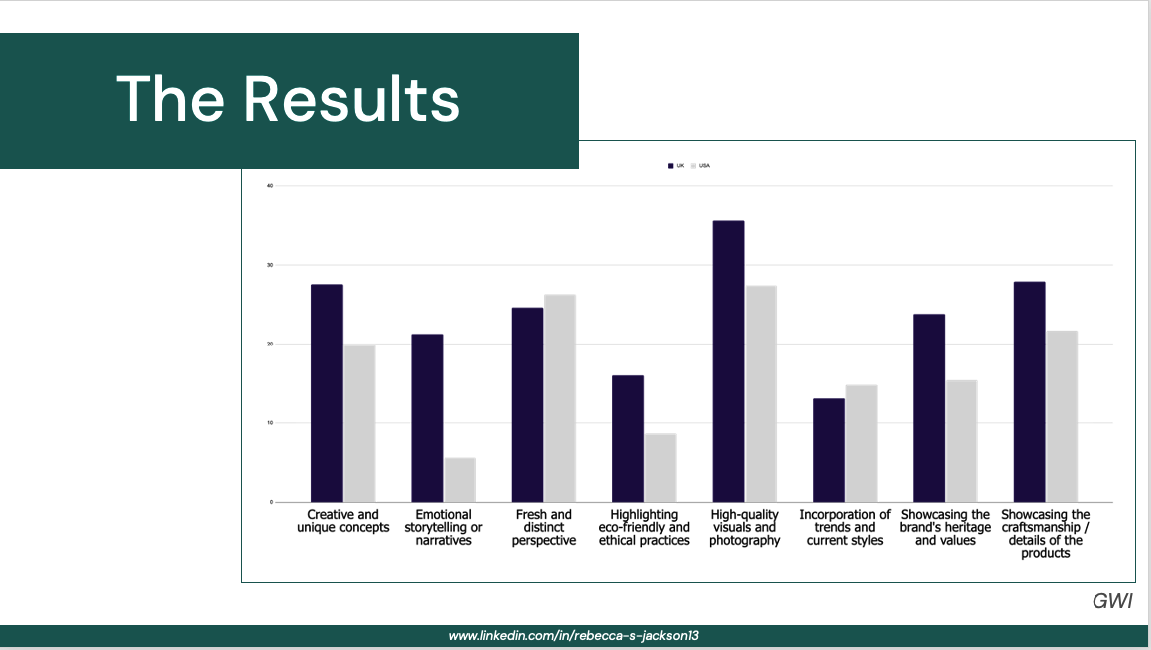
Responses point to themes like high-quality visuals, craftsmanship, and unique concepts. From there, I build comprehensive personas that include demographics, psychographics like esteem and ambition, and purchasing behavior.
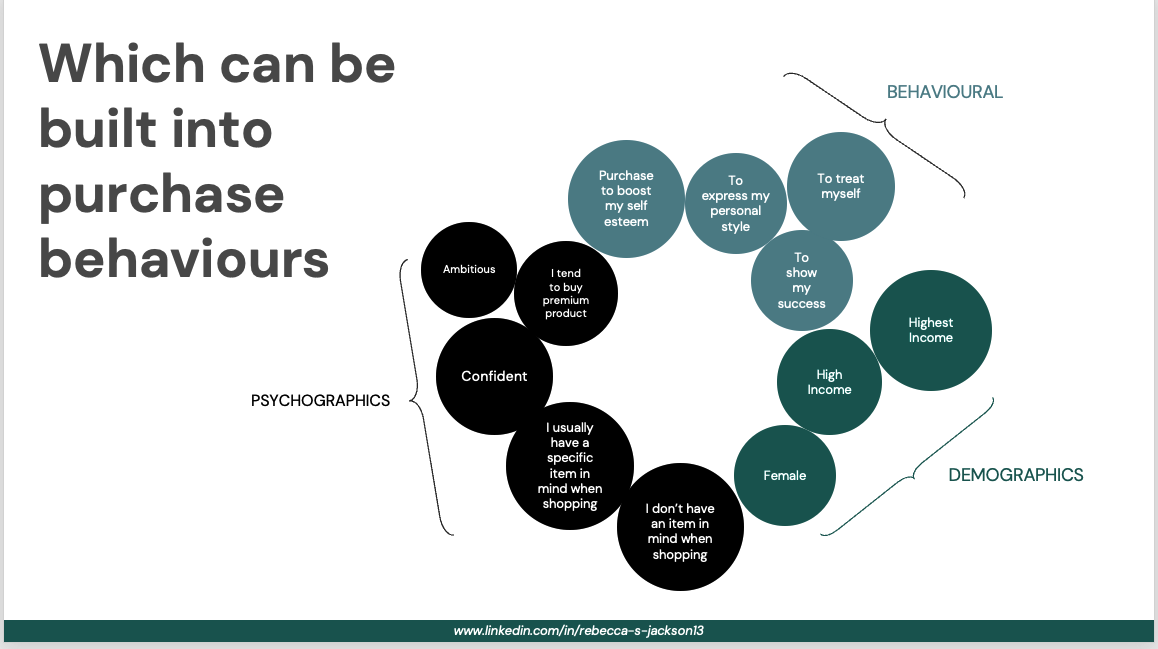
These profiles show me how a visitor moves from discovery to decision.
Turn audience data into a conversion strategy
Once I’ve built audience profiles, the next step is translating them into a strategy that drives conversions.
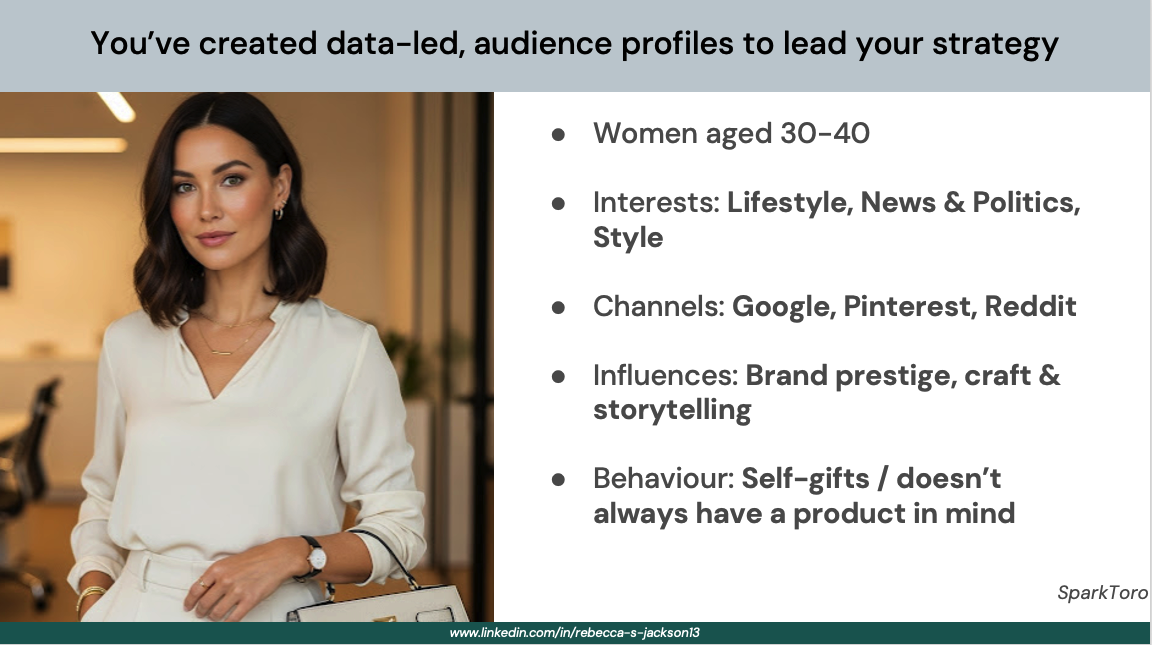
SparkToro helped me understand that my ideal customers are women aged 30-40 who spend time on Reddit, Google, and Pinterest. They care about brand prestige and storytelling and love treating themselves to gifts.
I can use this information for targeting in the following ways:
Create content for life events:
Build campaigns around events like weddings, anniversaries, and seasonal gifting. These moments often align with higher purchase intent.
Use channels where your audience is most active:
Pinterest was driving aspiration for one client, while Reddit surfaced in research queries. I used the data to create visual storytelling for Pinterest and more practical, trust-building content to support Reddit conversations.
Use behavior cues to uncover long-tail demand:
Personas clarify which long-tail terms lead to purchase intent. Someone searching for “ivory clutch bag for wedding” is far more valuable than someone searching for “clutch bag.” These cues drive subcategory creation, page copy updates, and new content opportunities.
Address low clicks with a laser-focused keyword strategy
Clicks may be down, but you can still drive performance with the right keyword process. The trick is to ensure the pages you rank for match your audience's search intent.
Here’s how:
Step 1: Export your keyword data
Use a competitor analysis tool to export a list of keywords you rank for, plus keywords your competitors also rank for.
You can export a keyword list by navigating to the Keyword Gap feature in Moz Pro and entering your URL alongside competitors.
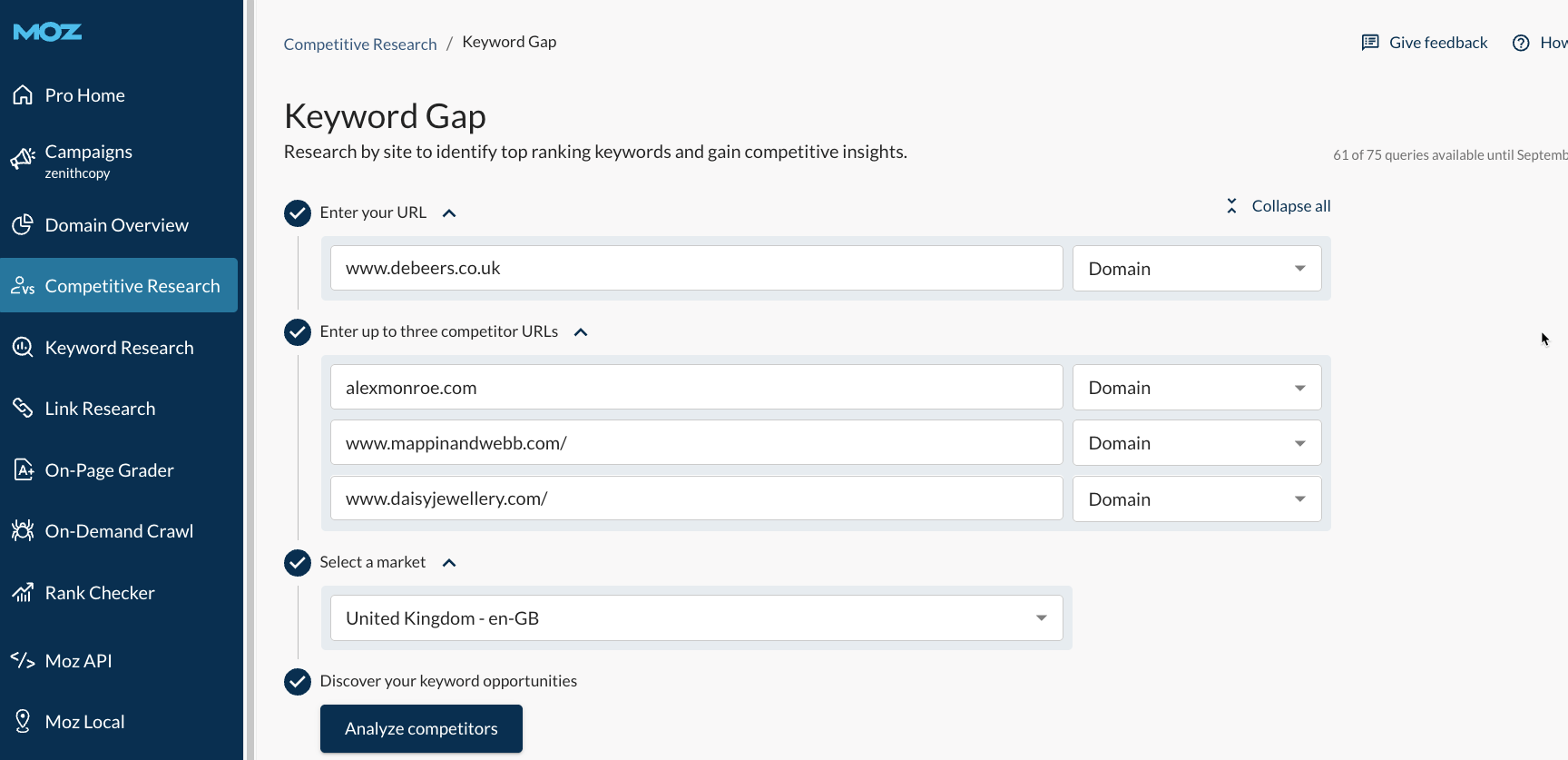
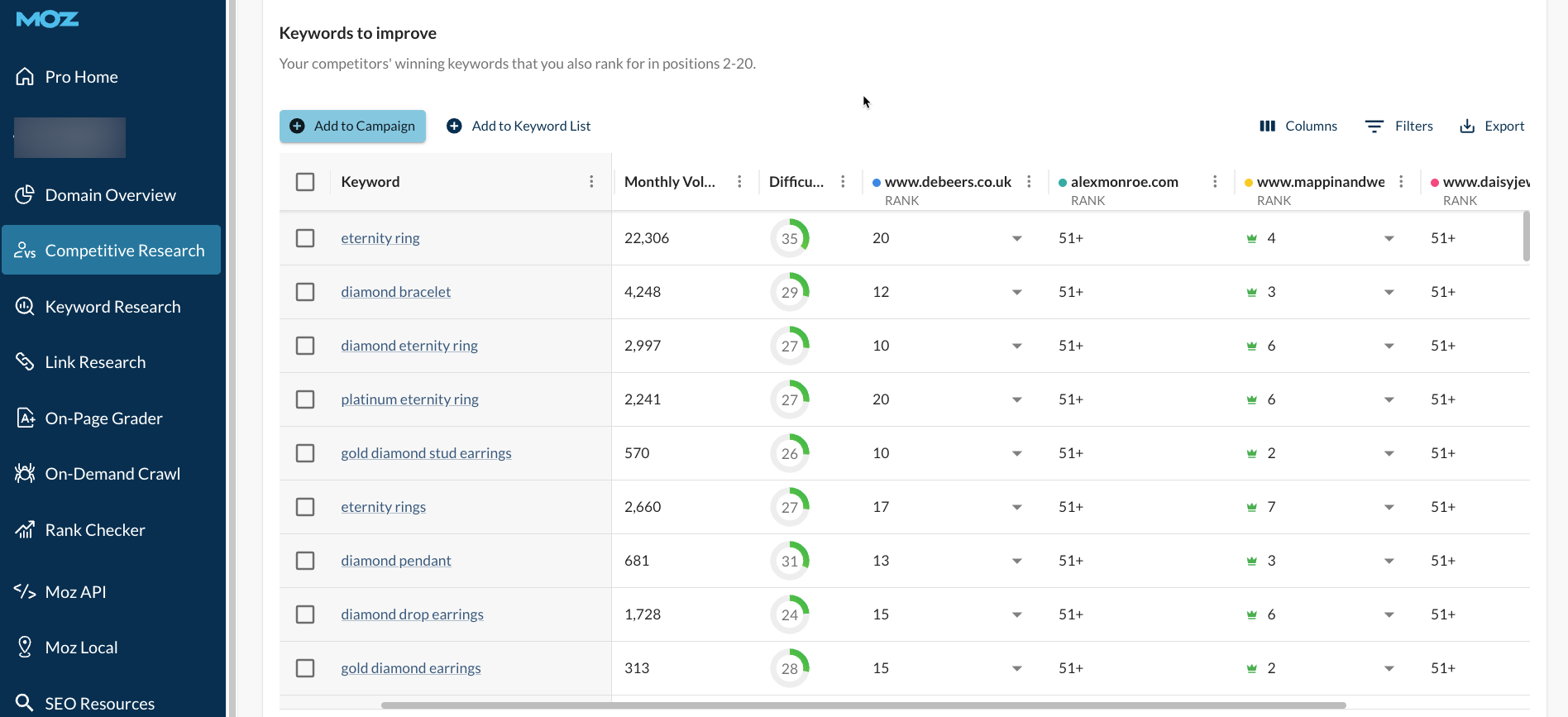
Expect thousands of terms, but you’ll simplify this in the next step.
Step 2: Segment keywords by intent
Create a sheet with three intent categories:
- Informational: Early-stage discovery terms.
- Commercial: Category-driven terms best handled with product listing pages (PLP).
- Transactional: Specific product terms best handled with product detail pages (PDPs).
Next, tag every keyword to see whether your pages rank where they should.

Step 3: Identify opportunity clusters using competitor data
Overlay competitor rankings. Look for areas where competitors hold positions that you don’t.

Group these into topic clusters that align with your audience research—events like engagement and anniversary, or product attributes like colour and cut. These are your opportunity areas.
Step 4: Use long-tail keywords to reduce reliance on branded queries
Too many sites still lean on branded traffic for growth. That works until impressions plateau and revenue flatlines.

To unlock growth, target long-tail queries that reflect your audience’s priorities and unique product USPs. These aren’t the highest-volume terms, but they’re most likely to convert.
Generic keywords like “clutch bag” are too broad and competitive. Instead, focus on high-intent terms that tie into events, occasions, or materials—“ivory clutch bag for wedding” or “beaded evening clutch.” These searches come from buyers closer to purchase and reduce reliance on branded queries.
Use audience behavior and keyword data to feed your SEO strategy
I translate audience behavior and keyword data into three streams of execution.
New subcategory opportunities
Audit which page types rank for your product terms. If PDPs are ranking for broad queries, you’re wasting intent. Fixing the target page type reduced bounce rate and built authority for the page.
Create new categories around these long-tail clusters and integrate them into your navigation.
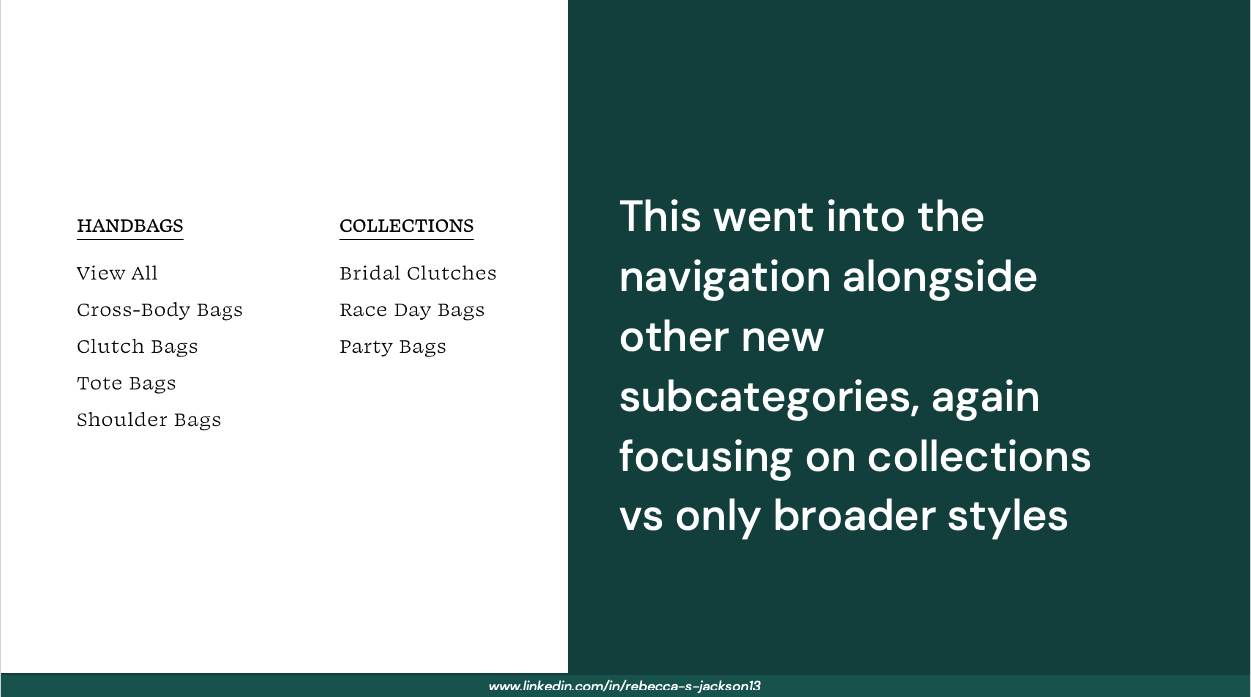
For LK Bennett, we added event-based subcategories, such as bridal clutches, race day bags, and party bags, to diversify rankings beyond brand terms.

Work with trade teams to add the long-tail language directly into subcategory headers. It ties navigation, search demand, and user experience together and ensures your teams can work more holistically with not only a commercial intent, but a digitally focused one.
PDP enhancements for higher conversion
Rewrite the PDP copy to reflect themes from your audience research. Add use cases and styling cues your audience cares about, and structure the content into scannable sections.
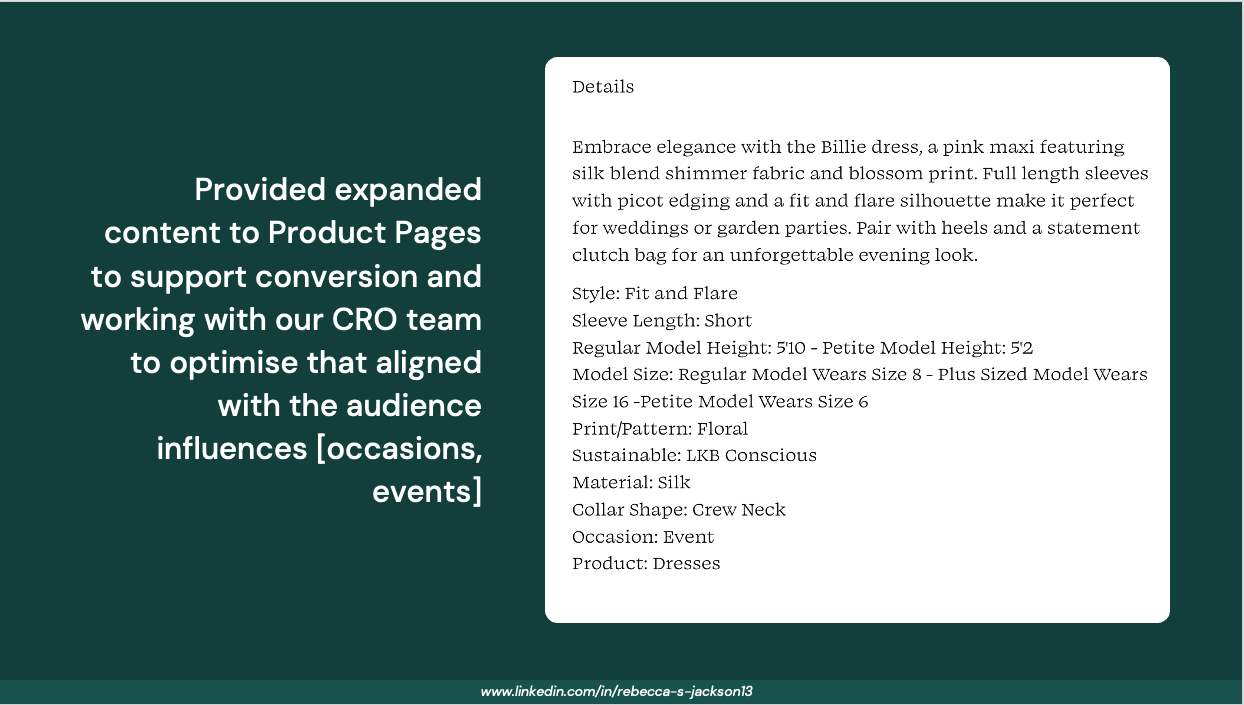
For this client, we aligned PDP content with purchase triggers like gifting occasions and personal milestones, resulting in a lift in conversion as well as supporting our targeting by showing we understood our audiences with products.
Support categories with editorial content
Create blog posts, guides, and what-to-wear content around these key events.

Link them to the relevant subcategories to build authority and reinforce the intent match for users and search engines.
Collaborate across teams to scale impact
Share long-tail opportunities with CRO, content, and PR. For example, CRO used the data to optimize PDP layouts, while PR and content teams created campaigns and coverage around the same USPs. This cross-team alignment kept every channel working toward the same conversion goals.
For LK Bennett, this approach delivered:
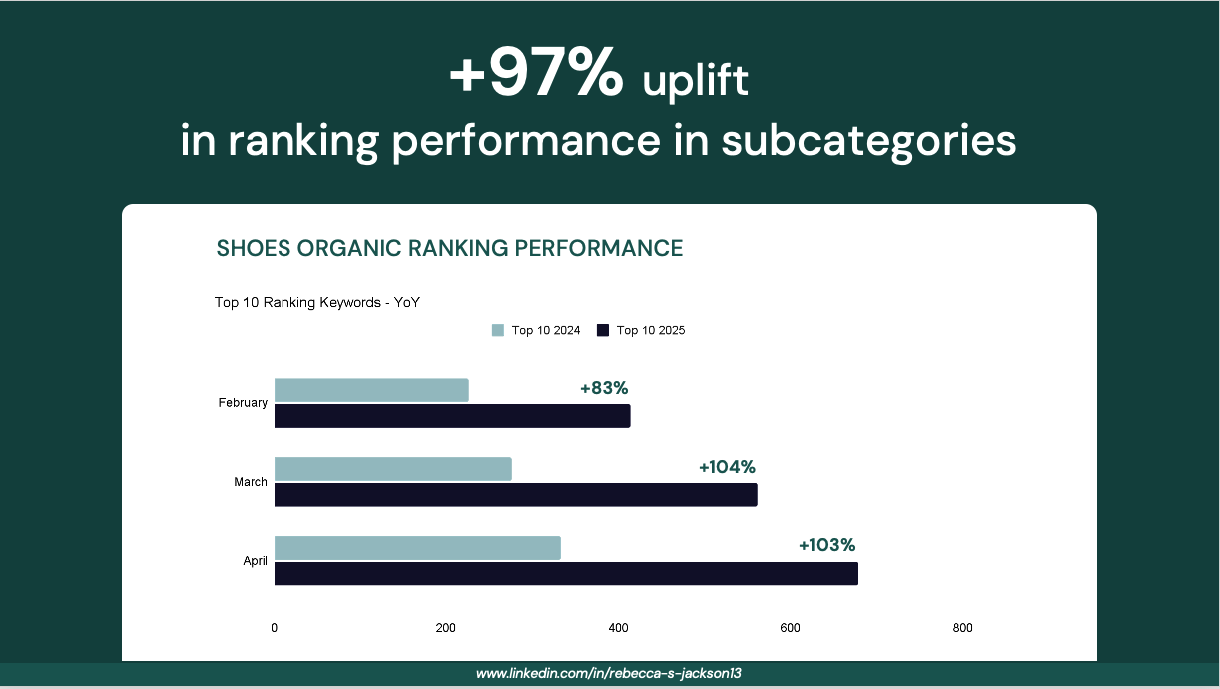
- +600 appearances in AI Overviews
- +97% increase in ranking performance
- +160% YoY revenue growth for subcategories
Think beyond your site to search ecosystems
Forums, communities, and social platforms are now core parts of the search journey. If you ignore these spaces, you’re missing the conversations that shape visibility in SERPs and AI results.
Reddit threads now appear in SERPs and feed into LLM results, making it a high-value channel for brands.
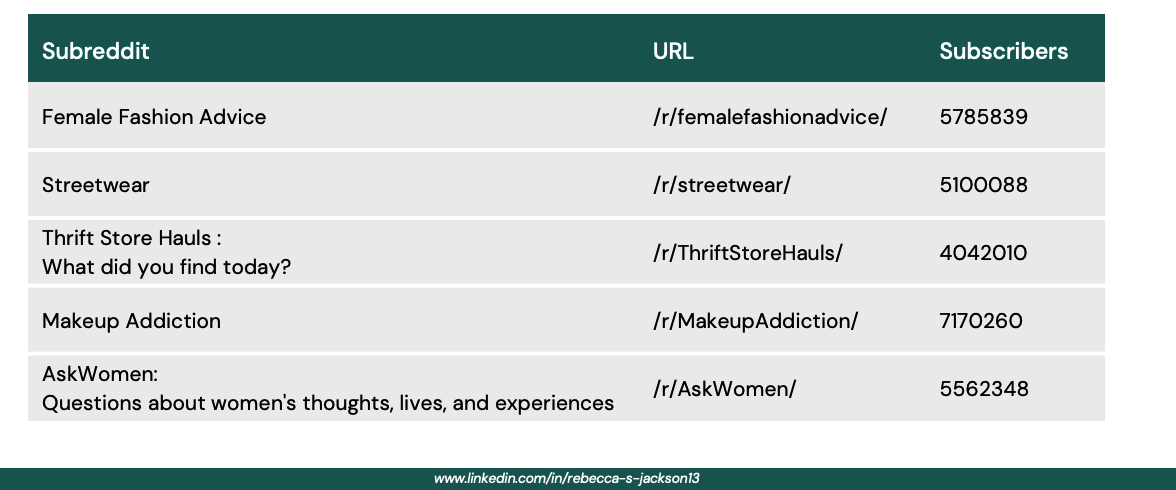
Reddit is also a goldmine for research. Subreddits like r/FemaleFashionAdvice or r/MakeupAddiction revealed insights on product sentiment, purchase triggers, and common phrases people used when looking for items.
We used these insights to sharpen audience personas, uncover long-tail keyword opportunities, and align content messaging with how people talk and search.
Get actionable insights to fix declining traffic and improve AI visibility
only at MozCon New York

Show SEO impact with measurable outcomes
One of the biggest misconceptions is that SEO is becoming difficult to measure due to fragmented search and AI. That’s not true. You can show clear value when you track the right signals.
Here’s what to measure:
- Indexed results in SERPs and AI overviews: Check which brand mentions and threads appear.
- Ranking improvements: Monitor category and long-tail keyword gains with tracking in Moz Pro Campaigns.
- Referral traffic from Reddit: Track GA4 to see which posts send referral traffic.
- Brand mentions: Measure visibility across AI overviews to validate authority.
Conclusion: Win conversions, not vanity metrics
Search may be fragmented across platforms, but the path to organic conversion hasn’t changed. When you understand your audience and how they search, you can create an SEO strategy that drives results without more traffic.
The author's views are entirely their own (excluding the unlikely event of hypnosis) and may not always reflect the views of Moz.





